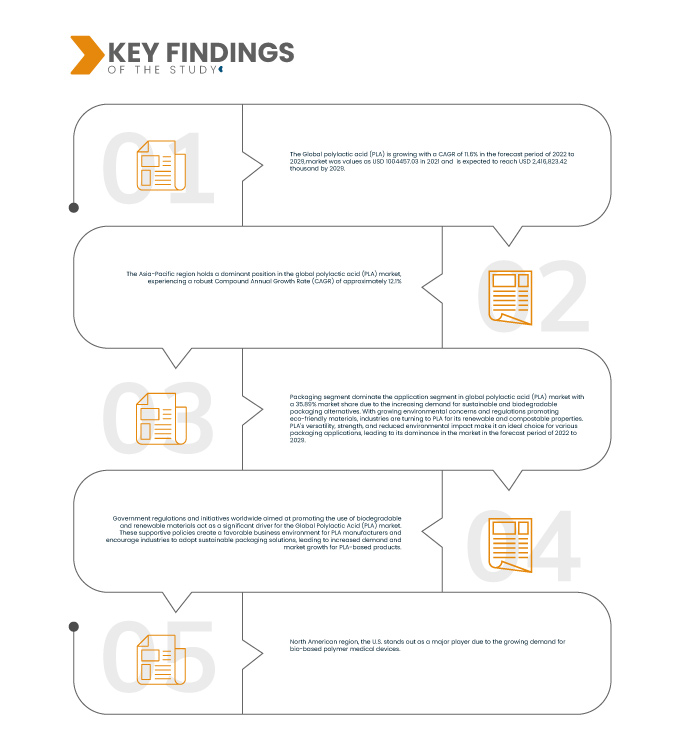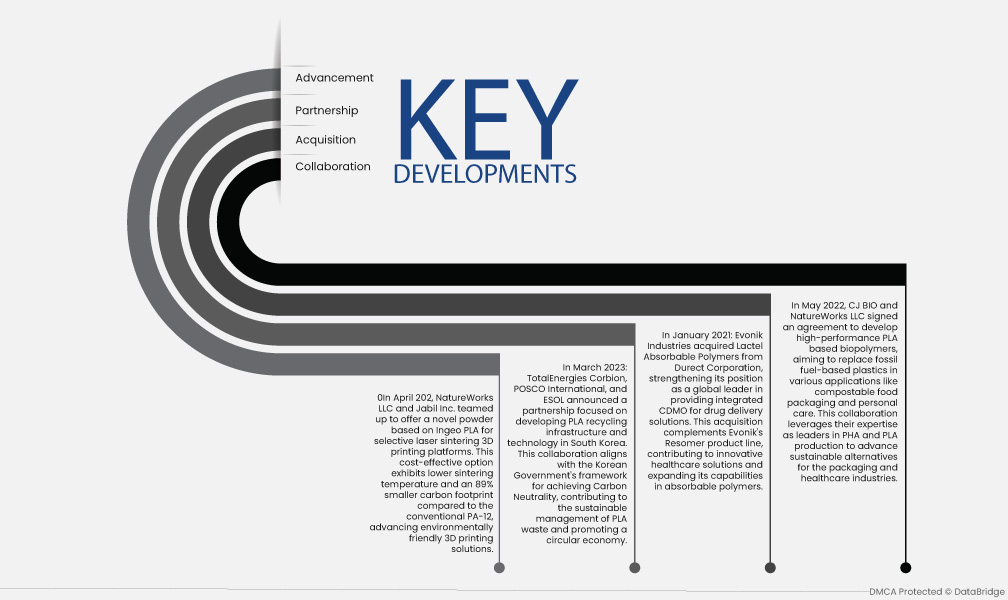Рынок полимолочной кислоты (PLA) переживает значительный рост, обусловленный ее возобновляемой и биоразлагаемой природой. Получаемая из возобновляемых источников, таких как кукурузный крахмал и сахарный тростник, PLA обладает полезными механическими свойствами по сравнению с другими биоразлагаемыми полимерами. Будучи термопластичным алифатическим полимером, она производится путем кристаллизации молочной кислоты. Ее химическая формула (C3H4O2) n и полукристаллическая, гидрофобная природа позволяют ей разлагаться на биоразлагаемые компоненты, что делает ее пригодной для различных применений.
Доступ к полному отчету по адресу https://www.databridgemarketresearch.com/reports/global-polylactic-acid-pla-market
Data Bridge Market Research анализирует, что глобальный рынок полимолочной кислоты (PLA) растет с CAGR 11,6% в прогнозируемый период с 2022 по 2029 год, рынок оценивался в 10 04 457,03 долларов США в 2021 году и, как ожидается, достигнет 2 416 823,42 тысяч долларов США к 2029 году. Растущий спрос на устойчивую упаковку из-за экологических проблем стимулирует принятие PLA в качестве жизнеспособной альтернативы. Как биоразлагаемый и экологически чистый материал, PLA отвечает потребностям потребителей и отраслей, ищущих экологически ответственные упаковочные решения.
Основные выводы исследования
Ожидается, что снижение зависимости от пластика на основе нефти будет способствовать темпам роста рынка.
Снижение зависимости от пластика на основе нефти является ключевым фактором развития мирового рынка полимолочной кислоты (PLA). Как возобновляемая и биооснованная альтернатива, PLA снижает зависимость от ископаемого топлива, смягчая воздействие на окружающую среду и поддерживая круговую экономику. Отрасли, ищущие устойчивые решения, обращаются к PLA из-за его биоразлагаемых свойств и меньшего углеродного следа. Стремление к экологически чистым методам и желание сократить пластиковые отходы стимулируют принятие PLA.
Область отчета и сегментация рынка
Отчет Метрика
|
Подробности
|
Прогнозируемый период
|
2022-2029
|
Базовый год
|
2021
|
Исторические годы
|
2020 (Можно настроить на 2014-2019)
|
Количественные единицы
|
Доход в млн. долл. США, объемы в единицах, цены в долл. США
|
Охваченные сегменты
|
Тип (рацемическая PLLA (поли-L-молочная кислота), обычная PLLA (поли-L-молочная кислота), PDLA (поли-D-молочная кислота) и PDLLA (поли-Dl-молочная кислота)), сырье (кукуруза, маниока, сахарный тростник, сахарная свекла и другие), форма (пленки и листы, покрытия, волокна и другие), применение (упаковка, транспорт, сельское хозяйство, медицина, электроника, текстиль, гигиена и другие), конечный пользователь (пластиковые пленки, бутылки, биоразлагаемые медицинские устройства)
|
Страны, охваченные
|
США, Канада, Мексика, Великобритания, Россия, Франция, Испания, Италия, Германия, Турция, Нидерланды, Швейцария, Бельгия, остальные страны Европы, Япония, Китай, Южная Корея, Индия, Сингапур, Таиланд, Индонезия, Малайзия, Филиппины, Австралия и остальные страны Азиатско-Тихоокеанского региона, Бразилия, Аргентина, остальные страны Южной Америки, Египет, Саудовская Аравия, Объединенные Арабские Эмираты, Южная Африка, Израиль и остальные страны Ближнего Востока и Африки.
|
Охваченные участники рынка
|
BASF SE (Германия), Futerro (Бельгия), NatureWorks LLC (США), TotalEnergies Corbion (Нидерланды), Sulzer Ltd (Швейцария), Mitsubishi Chemical Corporation (Япония), TORAY INDUSTRIES, INC. (Япония), Merck KGaA (Германия), Musashino Chemical Laboratory, Ltd. (Япония), Evonik Industries AG (Германия), Polyvel Inc. (США), UNITIKA LTD. (Япония), Jiangxi Academy of Sciences Biological New Materials Co., Ltd. (Китай), Shanghai Tong-jie-liang Biomaterials Co., Ltd. (Китай), Zhejiang Hisun Biomaterials Co., Ltd. (Китай), Radici Partecipazioni SpA (Италия)
|
Данные, отраженные в отчете
|
Помимо аналитических данных о рыночных сценариях, таких как рыночная стоимость, темпы роста, сегментация, географический охват и основные игроки, рыночные отчеты, подготовленные Data Bridge Market Research, также включают в себя углубленный экспертный анализ, эпидемиологию пациентов, анализ воронки продаж, анализ ценообразования и нормативную базу.
|
Анализ сегмента:
Мировой рынок полимолочной кислоты (ПЛА) сегментирован по типу продукта, типу раны, классу раны, конечному пользователю и каналу сбыта.
- На основе типа глобальный рынок полимолочной кислоты (PLA) подразделяется на пять сегментов, а именно: рацемическая PLLA (поли-L-молочная кислота), обычная PLLA (поли-L-молочная кислота), PDLA (поли-D-молочная кислота), PDLLA (поли-Dl-молочная кислота) и смеси PLA. Ожидается, что в 2022 году сегмент рацемической PLLA (поли-l-молочная кислота) будет доминировать на мировом рынке полимолочной кислоты (PLA) с долей рынка 37,59% из-за простоты смешивания с различными материалами и образования сополимеров в прогнозируемый период с 2022 по 2029 год.
Ожидается, что в 2022 году сегмент рацемической ПЛМК (поли-L-молочной кислоты) будет доминировать на мировом рынке полимолочной кислоты (ПЛК).
Ожидается, что в 2022 году сегмент рацемической PLLA (поли-l-молочной кислоты) будет доминировать на мировом рынке полимолочной кислоты (PLA) с долей рынка 37,59% благодаря своим превосходным свойствам, включая высокую кристалличность и термическую стабильность. Она широко применяется в упаковке, текстиле и медицинских приборах, предлагая надежную и экологичную альтернативу обычным пластикам, что обусловливает ее широкое внедрение и доминирование на рынке в прогнозируемый период с 2022 по 2029 год.
- На основе сырья мировой рынок полимолочной кислоты (PLA) подразделяется на пять сегментов: кукуруза, маниока, сахарный тростник, сахарная свекла и другие. Ожидается, что в 2022 году сегмент сахарного тростника будет доминировать на мировом рынке полимолочной кислоты (PLA) с долей рынка 36,40%, поскольку это более выгодное сырье, которое дает более высокую урожайность с гектара, чем другие виды сырья, такие как кукуруза или рис, в прогнозируемом периоде с 2022 по 2029 год.
- На основе формы мировой рынок полимолочной кислоты (PLA) подразделяется на четыре сегмента: волокна, пленки и листы, покрытия и др. Ожидается, что в 2022 году сегмент пленок и листов будет доминировать на мировом рынке полимолочной кислоты (PLA) с долей рынка 53,46% благодаря своей низкой стоимости и широкому ассортименту цветов и смесей в прогнозируемом периоде с 2022 по 2029 год.
- На основе сферы применения мировой рынок полимолочной кислоты (PLA) подразделяется на восемь сегментов: упаковка, сельское хозяйство, транспорт, медицина, электроника, текстиль, гигиена и другие. Ожидается, что в 2022 году сегмент упаковки будет доминировать на мировом рынке полимолочной кислоты (PLA) с долей рынка 35,89%, поскольку материалы на основе PLA, используемые в упаковке, могут быть компостируемыми там, где имеются коммерческие предприятия по компостированию, что предотвращает их захоронение на свалках в прогнозируемый период с 2022 по 2029 год.
В 2022 году сегмент упаковки будет доминировать в сегменте применения на мировом рынке полимолочной кислоты (ПЛА)
В 2022 году сегмент упаковки будет доминировать на мировом рынке полимолочной кислоты (PLA) с долей рынка 35,89% из-за растущего спроса на устойчивые и биоразлагаемые альтернативы упаковки. С ростом экологических проблем и нормативных актов, продвигающих экологически чистые материалы, отрасли обращаются к PLA из-за его возобновляемых и компостируемых свойств. Универсальность, прочность и сниженное воздействие PLA на окружающую среду делают его идеальным выбором для различных упаковочных применений, что приведет к его доминированию на рынке в прогнозируемый период с 2022 по 2029 год.
- На основе конечного использования глобальный рынок полимолочной кислоты (PLA) подразделяется на три сегмента: пластиковые пленки , бутылки и биоразлагаемые медицинские устройства. Ожидается, что в 2022 году сегмент пластиковых пленок будет доминировать на мировом рынке полимолочной кислоты (PLA) с долей рынка 61,42% из-за их гибкости и простоты формования в прогнозируемый период с 2022 по 2029 год.
Основные игроки
Data Bridge Market Research признает следующие компании основными игроками на мировом рынке полимолочной кислоты (PLA): BASF SE (Германия), Futerro (Бельгия), NatureWorks LLC (США), TotalEnergies Corbion (Нидерланды), Sulzer Ltd (Швейцария), Mitsubishi Chemical Corporation (Япония), TORAY INDUSTRIES, INC. (Япония), Merck KGaA (Германия), Musashino Chemical Laboratory, Ltd. (Япония),
Развитие рынка
- В мае 2022 года CJ BIO и NatureWorks LLC подписали соглашение о разработке высокопроизводительных биополимеров на основе PLA, нацеленных на замену пластика на основе ископаемого топлива в различных областях применения, таких как компостируемая упаковка для пищевых продуктов и средства личной гигиены. Это сотрудничество использует их опыт как лидеров в производстве PHA и PLA для продвижения устойчивых альтернатив для упаковочной и медицинской отраслей.
- В январе 2021 г.: Evonik Industries приобрела Lactel Absorbable Polymers у Durect Corporation, укрепив свои позиции мирового лидера в предоставлении интегрированных CDMO для решений по доставке лекарств. Это приобретение дополняет линейку продуктов Resomer компании Evonik, способствуя инновационным решениям в области здравоохранения и расширяя ее возможности в области абсорбируемых полимеров.
- В марте 2023 года: TotalEnergies Corbion, POSCO International и ESOL объявили о партнерстве, направленном на развитие инфраструктуры и технологий переработки PLA в Южной Корее. Это сотрудничество соответствует программе правительства Кореи по достижению углеродной нейтральности, способствуя устойчивому управлению отходами PLA и продвигая круговую экономику.
- 0В апреле 202 г. NatureWorks LLC и Jabil Inc. объединились, чтобы предложить новый порошок на основе Ingeo PLA для селективного лазерного спекания платформ 3D-печати. Этот экономически эффективный вариант демонстрирует более низкую температуру спекания и на 89% меньший углеродный след по сравнению с обычным PA-12, продвигая экологически чистые решения 3D-печати.
Региональный анализ
Географически в отчете о мировом рынке полимолочной кислоты (ПЛА) представлены следующие страны: США, Канада, Мексика, Великобритания, Россия, Франция, Испания, Италия, Германия, Турция, Нидерланды, Швейцария, Бельгия, остальные страны Европы, Япония, Китай, Южная Корея, Индия, Сингапур, Таиланд, Индонезия, Малайзия, Филиппины, Австралия и остальные страны Азиатско-Тихоокеанского региона, Бразилия, Аргентина, остальные страны Южной Америки, Египет, Саудовская Аравия, Объединенные Арабские Эмираты, Южная Африка, Израиль и остальные страны Ближнего Востока и Африки.
Согласно анализу Data Bridge Market Research:
Азиатско-Тихоокеанский регион будет доминирующим регионом на мировом рынке полимолочной кислоты (ПЛА) в прогнозируемый период 2022–2029 гг.
Азиатско-Тихоокеанский регион занимает доминирующее положение на мировом рынке полимолочной кислоты (PLA), демонстрируя устойчивый среднегодовой темп роста (CAGR) около 12,1%. Этот рост объясняется различными факторами, включая большую численность населения региона, растущую осведомленность об устойчивости и правительственные инициативы, продвигающие экологически чистые материалы. Кроме того, растущий спрос на биоразлагаемые альтернативы упаковке в бурно развивающейся упаковочной отрасли Азиатско-Тихоокеанского региона еще больше стимулирует внедрение PLA.
По оценкам, Северная Америка станет самым быстрорастущим регионом на мировом рынке полимолочной кислоты (ПЛА) в прогнозируемый период 2022–2029 гг.
В североамериканском регионе США выделяются как крупный игрок из-за растущего спроса на медицинские изделия из биополимеров. С сильным акцентом на здравоохранение и стремлением к устойчивым решениям сектор здравоохранения США принимает медицинские изделия на основе PLA, поскольку они обеспечивают биосовместимость и сниженное воздействие на окружающую среду по сравнению с традиционными материалами на основе нефти. Этот спрос на экологически чистые медицинские изделия способствует доминированию США на североамериканском рынке PLA.
Для получения более подробной информации об отчете о мировом рынке полимолочной кислоты (PLA) нажмите здесь – https://www.databridgemarketresearch.com/reports/global-polylactic-acid-pla-market












